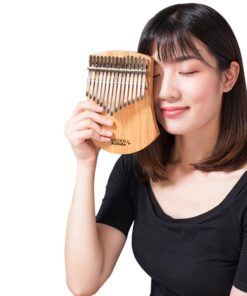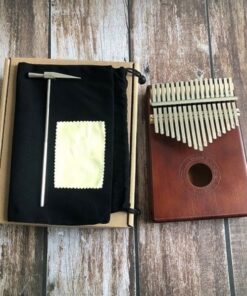[Kit Complet] Original Chromatic Kalimba 20 Notes in Acacia
98,84 €
Includes Original Chromatic Kalimba 20 Notes Complete Kit in Acacia :
1 Original Chromatic Kalimba 20 Notes in Acacia
1 Tuning hammer
1 English songbook
1 anti-slip sticker
1 Cleaning cloth
1 Housing
Out of stock
Included in the chromatic kalimba package:
- A chromatic Kalimba
- A tuning hammer
- An English songbook
- An anti-slip sticker
- A cleaning cloth
- A protective cover
This chromatic Kalimba has 20 keys, which represents a wider range than the traditional Hugues Tracy Kalimba.
Quality materials: Handcrafted with steel blades and a high-quality acacia resonance box. If you have the highest demands on sound quality, we invite you to choose this product.
A professional sound with no musical background required, you only have to move your thumb to get wonderful music that will enchant you for the rest of your life.
This chromatic Kalimba is the perfect instrument for performance, recording, family and relaxation. The Kalimba is an ideal tool for concerts, recordings, parties and family relaxation.
In the Pack :
- User manual: With our professionally produced chromatic kalimba instruction booklet, you'll be guided through the use of the Kalimba.
- Protective cover: kalimba covers can effectively protect your kalimba whatever the environment, preventing moisture, oxidation, scratches, drops, waterproofing and very easy to transport.
Description :
- Soundbox material: Acacia (koa)
- Notes : Carbon steel
- Style: Original 20-note Kalimba
- Size :35*115*138*185mm
- Product weight : 700g/24.7oz
How to play the Chromatic Kalimba?
Want a real challenge? Want a kalimba that can play any melody or harmony? Then the Chromatic Kalimba is your instrument. The Chromatic has the "white notes" on the front and the "black notes" on the back.
A major problem with most kalimbas is that they are tuned to the diatonic scale ("Do Re Mi Fa Sol La Si Do") and therefore lack the chromatic notes, which are sharps and flats, or accidentals (the note between "Do" and "Re", for example).
The simplified diatonic scale makes the kalimba easier to learn, but makes it difficult, if not impossible, to play complex pieces with key changes or notes outside the diatonic scale.
The Chromatic Kalimba looks like Hugh Tracey's Alto Kalimba on the front... but the notes that are usually absent from the Alto Kalimba (F, Bb, Eb, Ab, and Db) are present on the back.
It's hard to play the notes on the back with your fingers when you can't see them, but after many hours of serious work with the instrument, you'll have every note on a two-octave scale at your fingertips.
With the "flats on the back" played by your fingers, you can't really see them. Where are they? You can place black dots on the front teeth that have their flats immediately behind them.
The front teeth of G and C have no points: their flaws are F# and B, which are located on the front side.
Consequently, G and C have spaces behind them. The absence of dots on these teeth reminds us not to look for their flats behind them, but to find them on the front of the kalimba, played by the hand opposite the original unflatted note.
Some of the front teeth don't have flats on the back, but most do. You can use a Sharpie marker to make a small dot on the front teeth that have flats immediately behind them on the back.
You can see the correspondence of the front teeth without dots and the gaps in the chromatic back teeth. These can be removed with alcohol wipes.
When the dots fade, you can simply take your own Sharpie marker and put them back.
If you're not sure which teeth to place the points on, you can either go directly to the back teeth, or look at the chromatic tuning diagram.
The front teeth of the Kalimba Chromatique are all parallel, but the back teeth are spaced apart. Why is this?
The "flat" notes on the back are "just below" their non-"flat" counterparts on the front, and if you have very large hands, you can look at the on the front, imagine where the A flat is on the back just behind the A on the front, and nail it.
When we tried to do this, we always failed... that is, until we moved the rear left teeth a few mm to the left, and the rear right teeth a few mm to the right.
You can move the teeth from the back to the outside until they fit perfectly, and when you guess where they are, you get them almost every time.
We don't spread the back teeth when we send the Chromatic Kalimbas, in case you have big hands or don't want them that way. You're encouraged to play with the kalimba and move the teeth around until they fit.
![[Kit Complet] Original Chromatic Kalimba 20 Notes in Acacia Chromatic Kalimba](https://thekalimba.com/wp-content/uploads/2019/10/Kalimba-20-notes-Chromatique-3.jpg)
![[Kit Complet] Original Chromatic Kalimba 20 Notes in Acacia Chromatic Kalimba](https://thekalimba.com/wp-content/uploads/2019/10/Kalimba-20-notes-Chromatique-5.jpg)
![[Kit Complet] Original Chromatic Kalimba 20 Notes in Acacia chromatic kalimba](https://thekalimba.com/wp-content/uploads/2019/10/kalimba-chromatique.jpg)
Be the first to review “[Kit Complet] Kalimba Chromatique Original 20 Notes en Acacia”
Related products
Kalimba instrument
Kalimba instrument
Kalimba instrument
Customized 17-note electric kalimba - Personalized engraving
Kalimba instrument
Kalimba 17 Notes
Accessories / Bags
Kalimba instrument
Kalimba instrument


![[Complete Kit] 17-note Mahogany Kalimba Kalimba top sellers at TheKalimba](https://thekalimba.com/wp-content/uploads/2022/05/Kalimba-top-des-ventes-chez-TheKalimba-1-100x100.jpg)
![[Kit Complet] Original Chromatic Kalimba 20 Notes in Acacia Chromatic Kalimba 20 Notes](https://thekalimba.com/wp-content/uploads/2022/05/Kalimba-20-notes-Chromatique-8.jpg)
![[Kit Complet] Original Chromatic Kalimba 20 Notes in Acacia Kalimba 20 notes Chromatic](https://thekalimba.com/wp-content/uploads/2022/05/Kalimba-20-notes-Chromatique-5.jpg)
![[Kit Complet] Original Chromatic Kalimba 20 Notes in Acacia Kalimba 20 notes Chromatic](https://thekalimba.com/wp-content/uploads/2022/05/Kalimba-20-notes-Chromatique-3.jpg)
![[Kit Complet] Original Chromatic Kalimba 20 Notes in Acacia chromatic kalimba](https://thekalimba.com/wp-content/uploads/2022/05/kalimba-chromatique.jpg)
![[Kit Complet] Original Chromatic Kalimba 20 Notes in Acacia chromatic kalimba](https://thekalimba.com/wp-content/uploads/2022/05/Kalimba-Chromatique-2.jpg)

![[Kit Complet] Original Chromatic Kalimba 20 Notes in Acacia Kalimba 20 notes Chromatic](https://thekalimba.com/wp-content/uploads/2022/05/Kalimba-20-notes-Chromatique-5-247x296.jpg)
![[Kit Complet] Original Chromatic Kalimba 20 Notes in Acacia Kalimba 20 notes Chromatic](https://thekalimba.com/wp-content/uploads/2022/05/Kalimba-20-notes-Chromatique-3-247x296.jpg)
![[Kit Complet] Original Chromatic Kalimba 20 Notes in Acacia chromatic kalimba](https://thekalimba.com/wp-content/uploads/2022/05/kalimba-chromatique-247x296.jpg)
![[Kit Complet] Original Chromatic Kalimba 20 Notes in Acacia chromatic kalimba](https://thekalimba.com/wp-content/uploads/2022/05/Kalimba-Chromatique-2-247x296.jpg)
![[Kit Complet] Original Chromatic Kalimba 20 Notes in Acacia Chromatic Kalimba](https://thekalimba.com/wp-content/uploads/2019/10/Kalimba-chromatique-243x300.png)
![[Kit Complet] Original Chromatic Kalimba 20 Notes in Acacia chromatic kalimba](https://thekalimba.com/wp-content/uploads/2019/10/Kalimba-Chromatique-2.jpg)















Reviews
There are no reviews yet.